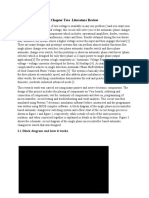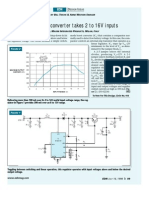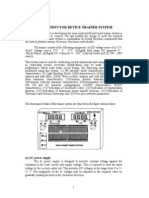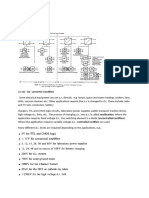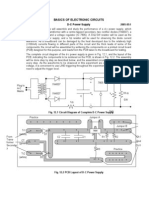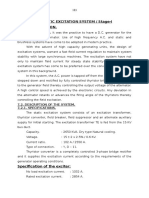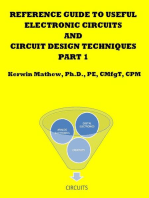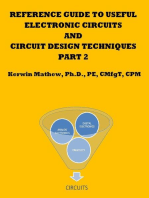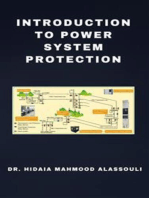Güç Elektroniği Dersi Güç Yarıiletkenleri Ile Prtik Devre Örnekleri
Güç Elektroniği Dersi Güç Yarıiletkenleri Ile Prtik Devre Örnekleri
Uploaded by
Kutay ÇetinCopyright:
Available Formats
Güç Elektroniği Dersi Güç Yarıiletkenleri Ile Prtik Devre Örnekleri
Güç Elektroniği Dersi Güç Yarıiletkenleri Ile Prtik Devre Örnekleri
Uploaded by
Kutay ÇetinOriginal Title
Copyright
Available Formats
Share this document
Did you find this document useful?
Is this content inappropriate?
Copyright:
Available Formats
Güç Elektroniği Dersi Güç Yarıiletkenleri Ile Prtik Devre Örnekleri
Güç Elektroniği Dersi Güç Yarıiletkenleri Ile Prtik Devre Örnekleri
Uploaded by
Kutay ÇetinCopyright:
Available Formats
G Elektronii / N.
Abut
G Elektronii Dersi G Yariletkenleri ile Prtik Devre rnekleri
0-24V 5A Ayarl Regleli G Kayna - 0-24V 5A Ayarl Regleli G Kayna Devresi - 0-24V 5A Ayarl Regleli G Kayna emas 0-24V 5A Ayarl Regleli G Kayna Devresi emas
The VCR converter: 12V to 12 V! 2 "att Many modern pieces of home electronics, like video recorders, have switching power supplies that can accept any voltage from about 90 to 250V A , at fre!uencies of "5 through at least several hundred #ert$% &ut it is less known that most of these power supply can perfectly well accept ' voltage too( )hat ' voltage should be at a level of close to what the A peak would be, that is, typically this e!uipment will accept about **0 to +20V ' % , live in a place where sometimes we get power cuts% ,t does not happen really often now, but when it happens, , hate having to re-program the memories and timer of my video cassette recorder( ,t looses memory as soon as the power outage lasts for more than a few seconds% &ut , have a large storage battery in my radio room, under constant charge, and given the low power consumption of a V ., , decided to put it on the battery% , looked inside, and tried to in/ect a backup voltage into the 01 circuitry, but having no schematic diagram , missed the proper spots, and the machine always kept forgetting everything% 2o , decided to power the entire V . from the battery, through the A power input% )he most obvious approach would be to make a ' to A inverter, having **0 or 220V A output at 50 or 30 #$, but this re!uires a rather large and heavy transformer% 2o it4s better to use a high fre!uency, at least 25k#$, so a very small and cheap transformer can be used% &ut sending 25 k#$ into a power supply designed for 50 to 30 #$ is no good( )he input diodes are not fast enough, and the noise filter at the input would place a heavy reactive load on the inverter( 2o , decided to rectify the secondary voltage in the converter, and power the V . with ' %
27
Pratik Devre emalar
Practical #$itch Volta%e Re%&lator Po$er #&''l( Circ&it "ith Positive )ncentives Convertor *etho+
)he practical switch voltage regulator power supply circuit is shown in the picture% )he positive incentives convertor method4s main features are5*%)he transformer winding4s primary and secondary has the same polarity%2%6hen V)* is connected, the current i* would be through 7p% At the same time the output side has current i2 conducted, and the output current is ,o% Also the inductor 8 is cumulating the energy%+%6hen the V)* is disconnected, the 84s opposite 9M: would make the current conducted through V'2%"%)he output side rectifier circuit is inductor input type whose switching fre!uency is beyond *00k#$% )he picture shows the practical switch voltage regulator power supply circuit with positive incentives convertor method%
28
G Elektronii / N. Abut
The s(,,etrical +o&-le T circ&it to i,'rove the notch .ilter circ&it
:igure * is an e;ample of the symmetrical double-) circuit% 1nder careful observation, we found that it is circuit synthesis of low-pass filter and high pass filter% ,n this circuit, usually the ratio of components grounding into the earth adopts 2 and . < 2 method% )he reason for this is that the ratio can effectively make the attenuation fre!uency reach the spike values, but the = value of this circuit is also dropped to 0%25, $ero fre!uency )he composition of the circuit is e;tremely simple, accoring to the circuit, we can see 2 capacitors is needed% )he author4s approach improves the cost, we can adopt two capacitors connected in parallel to process%
)he principle of circuit)he irrigation motor automatic protector circuit is formed by the power supply circuit and the detection<protection control circuit, which is shown in :igure "-93% 0ower supply circuit is formed by the power transformer ), rectifier diodes V'*-V'" and filter capacitor *% 'etection<protection control circuit is formed by the detection electrodes A,&,start button 2,resistors .*-.", capacitor 2, optical coupler V8 , bi-directional trigger diode V, thyristor V), electronic switch integrated circuit , and A contactor >M%
29
Pratik Devre emalar
Di%ital lock /
)he digital lock circuit is composed of the power switch 2?, power transformer ), bridge rectifier 1., relays >l, >2, password buttons 2l-2l2, transistors V), 89' V8l, V82, diodes V'*-V'", resistors .* -.+ and capacitors l- 3, and it is shown in :igure +-*0+% .l-.+ use the *<"6 carbon film resistors or metal film resistors% l- " select ultra small aluminum electrolytic capacitors with the voltage in *3V@ 5 uses the monolithic capacitor% V'*-V'" are choose *7"*"A silicon switch diode@ V'5 uses the l7"00B silicon rectifier diode%
Electronic -allast circ&it +ia%ra, .or .l&oresent la,'
)he electronic ballast circuit for fluorescent lamp is composed of the rectifier filter circuit, high-fre!uency oscillator circuit and output circuit% ,n the circuit, the rectifier filter circuit consists of the rectifier diodes V'*- V'" and filter capacitors *, 2@ high-fre!uency oscillator consists of the transistors vi, V2, resistors .*-.B, capacitors +, ", 3, diodes V'5- V'A and high fre!uency transformer ) C6*-6+ are wound on the same magnetic ring to form a high-fre!uency transformerD@ output circuit is composed of the chokes 8*, 82 and capacitors *- *0%
G Elektronii / N. Abut
Gro&n+ control electric .an circ&it +ia%ra,
*otor0s'ee+0control0$ith0tacho,eter0.ee+-ack
)his circuit shows a triac motor-speed control that derives feedback from a magnetcoil tachometer that is placed near the motor fan C:igs% A-*B& and A-*B D% Motor speed is controlled by the 5-kE pot% )he MA 2*0-" triac is capable of handling motor loads up to *0 A%
"
Pratik Devre emalar
1asic0#CR0control0circ&it0that0&ses0an0#1#
)his figure shows the basic control circuit for 2 .s that use 2&2 triggers, and is preferable to that of :ig% A-2" CtriacD, where high power must be handled, or whore rapidly rising voltages are encountered Chigh dv<dt,D% Although the circuits of both :igs% A-2" and A-25 were designed as incandescent-lamp dimmers, the circuits are well suited to control of universal and shaded-pole motors% 2uch motors have higher tor!ue at low speeds when open-loop controlled by these circuits, rather than with rheostats or variable transformers Cbecause of the higher voltage pulses appliedD%
1asic0triac0control0circ&it0that0&ses0an0#1#
#$i% &i'ure %$o(% t$e ba%i) )ontrol )ir)uit &or tria)% t$at u%e *+* tri''er%. #$e line volta'e an,
2
G Elektronii / N. Abut
loa, )urrent ,e-en, -rimaril. on t$e tria) )$ara)teri%ti)%. /n t$i% )a%e0 t$e 1A22"!34 a))ommo,ate% loa,% u- to "! A.
Electronic0cro$-ar
)his circuit provides positive protection of e;pensive electrical or electronic e!uipment against e;cessive supply voltage Cresulting from improper switching, short circuits, failure of regulators, etc%D% )he circuit is used where it is economically desirable to shut down e!uipment, rather than allow the e!uipment to operate at e;cessive voltages% )he circuit !uickly places a short across the power lines Cac or dcD, and thereby drops the voltage to the protected device to near $ero and blows a fuse% 6ith the values shown, the crowbar operating point Cset pointD can be ad/usted over the range of 30 to *20 Vdc or "2 to A" Vac% )he values of .* to .+ can be changed to cover different supply voltages, but the triac voltage rating must be greater than the highest operating point that is set by .2% 8amp ,, Cwith a voltage rating that is e!ual to the supplyD can be used to check the set point and operation of the circuit, by opening the push-to-test switch and ad/usting the input or set point to fire the 2&2% An alarm unit such as the Mallory 2onalert can be connected across the fuse to provide an audible indication of crowbar action% 7otice that this circuit cannot act on short, infre!uent power-line transients%
Pratik Devre emalar
2ine0o'erate+0level0s$itch
)his circuit uses a
A+093 or
A+093A transistor array to control a triac%
3n0o..0to&ch0s$itch
#$i% )ir)uit u%e% a 2A 24!E to %en%e %mall )urrent% &lo(in' bet(een )onta)t -oint% on a tou)$ -late0 ($i)$ )on%i%t% o& a P2 boar, metali5ation 'ri,. 6$en t$e 7n -late i% tou)$e,0 )urrent &lo(% bet(een t$e t(o $alve% o& t$e 'ri,0 an, )au%e% a -o%itive %$i&t in t$e out-ut volta'e 8-in 79 o& t$e 2A 24!E. #$e%e -o%itive tran%ition% are &e, into t$e 2A !790 ($i)$ i% u%e, a% a lat)$in' )ir)uit an, 5ero3)ro%%in' tria) ,river. 6$en -in7 o& t$e 2A 24! i% -o%itive0 t$e tria) an, lam- are on. #$e o--o%ite o))ur% ($en t$e 7&& -late i% tou)$e,0 an, -in " o& t$e 2A 24! i% -o%itive.
G Elektronii / N. Abut
Te,'erat&re0controller
)his circuit shows a controller%
A+09"& and triac that are connected to form a temperature
0"0so.t0start0li%ht0+i,,er
)his circuit shows the basic 1F) building block C:ig% 9-*D, which is used in a light dimmer with soft-start operation that applies current to the light slowly enough to eliminate high surges Chigh inrush currentD% )hese current surges, found in most cold-filament light dimmers, shorten lamp life% 6ith this circuit, the lamp is heated slowly by a gradually increasing voltage so that inrush current is kept to a minimum% ." controls the charging rate of 2 and provides the means to control or dim the lamp%
Pratik Devre emalar
5al.0$ave0th(ristor0control0$ith0avera%e0volta%e0.ee+-ack
)his circuit shows a 1F) used as a thyristor trigger Cwith feedbackD, where the average load voltage is the desired feedback variable% .*, .2, and * average the load voltage so that the voltage can be compared with the set point that is determined by . %
3'toco&'ler0+riven0#CR
#$i% )ir)uit %$o(% a 4N2; ,rivin' an *2<0 ($i)$0 in turn0 i% u%e, to )ontrol an in,u)tive loa,. #$e *2< i% a %en%itive3'ate ,evi)e 8 " mA o& 'ate )urrent9 an, t$e 4N2; $a% a minimum3 current transfer ratio of 0%2, so the "723 input current C,:D must be 5 mA% )he *-kE resistor prevents the 2 . from triggering with small input changes, and the *7"005 prevents the 2 . from triggering with the self-induced voltage when the 2 . turns off%
G Elektronii / N. Abut
Ti,e6Var(in% Di,,in% Circ&it
)he picture shows the time-varying dimming circuit%As shown, it uses the uni/unction transistor C1F)D trigger circuit, whose function is that it could make the lamp4s brightness light up gradually and automatically, or light out gradually and automatically Cwhich means the so-called soft starting or soft stoppingD% )his circuit could be used to control street lamp, home lamp, film-playing place, film-playing room and so on, and these cases would be very ade!uate% )his could make people4s eyes adapt to the photometric re!uirements gradually, so that it is good for eye4s health%)he working principle5 when the 2+ is connected, the circuit would get power supply% ,f the 2* is switched to upside, the *, 2 would be charged% &ecause the 24s two ports4 voltage is advanced than the *4s two ports4 voltage, the *4s charging voltage would be increased firstly and the 2 voltage would follow it to be increased% )he 2 .4s conduction angle would be wider and the lamp4s two ports4 voltage would be increased, so the lamp would be light up gradually%
Pratik Devre emalar
27 " #CR )nverter Circ&it
0ulse ' 9lectronic :ishing 'evice ircuit C+D
#$e Pul%e D2 Ele)troni) =i%$in' Devi)e 2ir)uit
G Elektronii / N. Abut
3ne kin+ o. electron -allast circ&it 'rinci'le +ia%ra,
#anhe #on%shi 17" vi-ratin% ,assa%e stick circ&it
8>ie(9
Pratik Devre emalar
P"* ,otor s'ee+ control circ&it
,ia'ram? P61 motor %-ee, )ontrol )ir)uit.
4!
G Elektronii / N. Abut
89" controlle+ silicon DC s'ee+ %overnin% s(ste, circ&it
Electric .an ste'less s'ee+ re%&lation circ&it +ia%ra,
Ele)tri) &an %te-le%% %-ee, re'ulation )ir)uit ,ia'ram i% %$o(n in t$e ,ia'ram? 8>ie(9 >ie( &ull 2ir)uit Dia'ram @ 2omment% @ <ea,in'8" ;9
engine oil pressure switch water temperature sensor braking smoke and air condition system circuit diagram
Publi%$e,?2!""343"! 2!? 9?!! Aut$or?muriel @ Ae.(or,? en'ine oil -re%%ure %(it)$0 (ater tem-erature %en%or0 brakin' %moke 0 air )on,ition %.%tem
4"
Pratik Devre emalar
=i'ure en'ine oil -re%%ure %(it)$(ater tem-erature %en%orbrakin' %moke an, air )on,ition %.%tem )ir)uit ,ia'ram 8>ie(9 >ie( &ull 2ir)uit Dia'ram @ 2omment% @ <ea,in'8"979
Air-condition front and back control assembly and ambient temperature control circuit diagram
Publi%$e,?2!""343"! 2!?2:?!! Aut$or?muriel @ Ae.(or,? Air3)on,ition &ront an, ba)k )ontrol a%%embl.0 ambient tem-erature )ontrol
=i'ure Air3)on,ition &ront an, ba)k )ontrol a%%embl. an, ambient tem-erature )ontrol )ir)uit ,ia'ram 8>ie(9 >ie( &ull 2ir)uit Dia'ram @ 2omment% @ <ea,in'8449
42
G Elektronii / N. Abut
The application circuit of EXB851
Publi%$e,?2!""3438 2?2;?!! Aut$or?ma.
8>ie(9 >ie( &ull 2ir)uit Dia'ram @ 2omment% @ <ea,in'8;"9
Application circuit of EXB8 !
Publi%$e,?2!""3438 2?"!?!! Aut$or?ma.
8>ie(9
4
Pratik Devre emalar
>ie( &ull 2ir)uit Dia'ram @ 2omment% @ <ea,in'8";!9
" type #$% structure and #&BT e'ui(alent circuit
Publi%$e,?2!""3438 2?!"?!! Aut$or?ma. @ Ae.(or,? D t.-e0 /P10 %tru)ture0 eBuivalent
8a9 D t.-e /P1 %tru)ture 8b9 /G+# eBuivalent )ir)uit 8>ie(9 >ie( &ull 2ir)uit Dia'ram @ 2omment% @ <ea,in'8"!29
Typical application wiring diagram of )*+1!A
Publi%$e,?2!""3438 "?:7?!! Aut$or?ma.
44
G Elektronii / N. Abut
8>ie(9 >ie( &ull 2ir)uit Dia'ram @ 2omment% @ <ea,in'8;:9
$ower module unit diagram of #&BT and fly-wheel diode
Publi%$e,?2!""3438 "?!7?!! Aut$or?ma. @ Ae.(or,? /G+#0 &l.3($eel ,io,e0 Po(er mo,ule
8a9 i% %in'le %(it)$ mo,uleC 8b9 i% t(o unit 8$al& bri,'e9 mo,uleC 8)9 i% D bri,'e 8%in'le -$a%e bri,'e9 mo,uleC 8,9 i% a%.mmetri)al D bri,'e mo,uleC 8e9 i% t$ree -$a%e bri,'e 8%iE unit or inverter bri,'e9 mo,uleC 8&9 i% )$o--in' mo,ule 8'9 i% )$o--in' mo,ule 8$9 i% t$ree -$a%e bri,'e GD a,, )$o--in' GAF 8brakin' )$o--er )ir)uit9 mo,uleC 8i9 i% t$ree unit mo,ule0 )on%i%t% o& t$ree 'rou- %(it)$C 8G9 i% %in'le %(it)$ a,, )olle)tor en, %erie% ,io,e 8 ne'ative ,ire)tion ,i%)onne)tin' %(it)$9 mo,uleC 8k9 i% %in'le %(it)$ a,, emitter en, %erie% ,io,e 8ne'ative ,ire)tion ,i%)onne)tin' %(it)$9 mo,uleC 8l9 i% t(o unit mo,ule0 (it$ %erie% ,io,e 8ne'ative ,ire)tion ,i%)onne)tin' %(it)$9. 8>ie(9
4:
Pratik Devre emalar
>ie( &ull 2ir)uit Dia'ram @ 2omment% @ <ea,in'8:8;9
,-* electron ballast circuit composed of %$#,.151$ and $ower*u/T% #&BT
Publi%$e,?2!""3432 ?2:?!! Aut$or?ma. @ Ae.(or,? ele)tron balla%t0 Po(erFuE#1 /G+#
8>ie(9 >ie( &ull 2ir)uit Dia'ram @ 2omment% @ <ea,in'8"499
The package of %itsubishi #$%
Publi%$e,?2!""3437 2!?48?!! Aut$or?ma. @ Ae.(or,? 1it%ubi%$i0
/P1 i% a,van)e, $.bri, inte'rate, -o(er ,evi)e. /t i% inte'rate, $i'$3%-ee,0 lo( -o(er )on%um-tion /G+# )$i- an, o-timal 'ri, ,rive )ir)uit an, kin,% o& -rote)tive )ir)uit in one
4;
G Elektronii / N. Abut
mo,ule. 2om-are to or,inar. /G+#0 /P1 $a% &urt$er in)rea%e in %.%tem &eature% an, reliabilit.. Al%o0 be)au%e it% )on,u)tion lo%%e% an, %(it)$ lo%%e% i% Buite lo(0 t$e %i5e o& ra,iator i% %mall0 %o %i5e o& t$e ($ole %.%tem i% more %mall. 1oreover /P1 internal inte'rate, lo'i)0 )ontrol0 ,ete)t ion an, -rote)t )ir)uit0 t$e u%e i% )onvenient0 it not onl. ,e)rea%e t$e volume o& t$i% %.%tem an, t$e ,evelo-ment time0 al%o 'reatl. a,, reliabilit. o& t$e %.%tem. 8>ie(9
47
You might also like
- Commissioning Report For RectifierDocument29 pagesCommissioning Report For RectifierAnujGarg100% (1)
- Busbar Stabllity Test Procedure and CalculationDocument8 pagesBusbar Stabllity Test Procedure and CalculationRitesh Jaiswal75% (4)
- Comparison Between LCC and VSCDocument5 pagesComparison Between LCC and VSCijsretNo ratings yet
- 6V To 220V Inverter SchematicDocument1 page6V To 220V Inverter Schematicthuylant100% (1)
- SIRIUS - Manual K40 - r1 - enDocument8 pagesSIRIUS - Manual K40 - r1 - engianfrancoNo ratings yet
- Electricity QuestionsDocument133 pagesElectricity QuestionskartavyajainNo ratings yet
- Alternator Power: Bangladesh University of Engineering & Technology Department of Electrical & Electronic EngineeringDocument7 pagesAlternator Power: Bangladesh University of Engineering & Technology Department of Electrical & Electronic EngineeringsabitavabiNo ratings yet
- Current Loop Application: Rolta Academy: Engineering Design ServicesDocument7 pagesCurrent Loop Application: Rolta Academy: Engineering Design ServicesRaj ChavanNo ratings yet
- Components List See Previous 12 Volts BatteryDocument7 pagesComponents List See Previous 12 Volts Batterysdio06No ratings yet
- Ieee Current ModeDocument7 pagesIeee Current ModepqqpNo ratings yet
- Electronics Assignment: by S.rudhraprakash 09lm55 Dme (SW)Document4 pagesElectronics Assignment: by S.rudhraprakash 09lm55 Dme (SW)rvikneshNo ratings yet
- Emergency Lighting Fluorescent Lamp: AbstractDocument20 pagesEmergency Lighting Fluorescent Lamp: AbstractAakash SheelvantNo ratings yet
- PNEUmatic Crane NewDocument26 pagesPNEUmatic Crane NewVignesh VaranNo ratings yet
- Half Wave and Full Wave RectifierDocument10 pagesHalf Wave and Full Wave RectifiersunilsathishNo ratings yet
- Chapter Two Literature ReviewDocument18 pagesChapter Two Literature ReviewAhmedNo ratings yet
- Controlled RectifiersDocument19 pagesControlled Rectifiersbalaji1986No ratings yet
- IEEE - 3 Phase Automatic ChangeoverDocument3 pagesIEEE - 3 Phase Automatic ChangeoverDuhanNo ratings yet
- Spice Model Laser Diode 15diDocument8 pagesSpice Model Laser Diode 15diParker333100% (1)
- CONTROLLING THE-WPS Office 12Document11 pagesCONTROLLING THE-WPS Office 12Odebunmi DammyNo ratings yet
- Ee 328 Lecture 1Document40 pagesEe 328 Lecture 1Hasan Hatice IlcalıNo ratings yet
- Automated Unified System For LPG UsingDocument84 pagesAutomated Unified System For LPG UsingVirat KaliNo ratings yet
- Thyristor Based HVDC SystemDocument5 pagesThyristor Based HVDC SystemAnonymous hzXy93FAE0% (1)
- Basic of ElectricalDocument10 pagesBasic of ElectricalAbdul RazzakNo ratings yet
- ICM21Document8 pagesICM21pldalpianNo ratings yet
- Lab ManualDocument87 pagesLab ManualSrividya KondaguntaNo ratings yet
- PWM 2 Level and 3 LevelDocument7 pagesPWM 2 Level and 3 LevelnewrajasinghNo ratings yet
- 2.1 Chapter 2 (BRB)Document3 pages2.1 Chapter 2 (BRB)Anil Kumar SinghNo ratings yet
- How To Control A StatorDocument3 pagesHow To Control A Statormsicoie1851No ratings yet
- Chap 3Document28 pagesChap 3Adem AbdelaNo ratings yet
- Project Report on a 9V DC Power SupplyDocument19 pagesProject Report on a 9V DC Power SupplyOlajuwonNo ratings yet
- Learn How A Variety Voltage Integrated Circuits and Them: To BuildDocument6 pagesLearn How A Variety Voltage Integrated Circuits and Them: To BuildSudheesh Puthanpurayil100% (1)
- SGS Technical Note 150 - 40 Industrial Application IdeasDocument32 pagesSGS Technical Note 150 - 40 Industrial Application IdeasPeterNo ratings yet
- Basic Lamp DimmerDocument2 pagesBasic Lamp DimmerejoaomelchiorsNo ratings yet
- Performance Analysis of Z Source Inverter Fed Induction Motor DriveDocument6 pagesPerformance Analysis of Z Source Inverter Fed Induction Motor DriveNagulapati KiranNo ratings yet
- Components Required - : Block DiagramDocument8 pagesComponents Required - : Block DiagramJethro MolenoNo ratings yet
- Electronic Circuits 2Document126 pagesElectronic Circuits 2tricky777No ratings yet
- Electronic Circuits 1Document112 pagesElectronic Circuits 1tricky777100% (1)
- Add Additional Information To Improve DiscoverabilityDocument5 pagesAdd Additional Information To Improve DiscoverabilityDereje Hailu0% (5)
- Matteini PHD Part1Document15 pagesMatteini PHD Part1Anonymous EnggrUsmNo ratings yet
- Battery Inverter For Modularly Structured PV Power Supply SystemsDocument4 pagesBattery Inverter For Modularly Structured PV Power Supply SystemsQM_2010No ratings yet
- A Review of AC ChoppersDocument8 pagesA Review of AC Choppersmjmvp234236No ratings yet
- DC To DC Converters: Version 2 EE IIT, Kharagpur 1Document10 pagesDC To DC Converters: Version 2 EE IIT, Kharagpur 1Deepak Kumar RajakNo ratings yet
- DC To DC Converters: Version 2 EE IIT, Kharagpur 1Document10 pagesDC To DC Converters: Version 2 EE IIT, Kharagpur 1கிரிதரன் கிரிNo ratings yet
- Fact Unit 2Document57 pagesFact Unit 2Ajaj MdNo ratings yet
- TransformerLess Low Cost Power SupplyDocument6 pagesTransformerLess Low Cost Power Supplyknk761987No ratings yet
- Automotive LED Buck ConverterDocument3 pagesAutomotive LED Buck Converternacional007100% (1)
- Zero-Voltage Switching Technique in DC/DC Converters: Abstruct-ADocument12 pagesZero-Voltage Switching Technique in DC/DC Converters: Abstruct-ARushikeshKatkarNo ratings yet
- International Refereed Journal of Engineering and Science (IRJES)Document8 pagesInternational Refereed Journal of Engineering and Science (IRJES)www.irjes.comNo ratings yet
- Expt09 - D-C Power SupplyDocument2 pagesExpt09 - D-C Power Supplypopmop2No ratings yet
- Unit 8: ObjectivesDocument39 pagesUnit 8: Objectiveshizami_hanafi7267No ratings yet
- HV Ee20m084 PowerlabDocument10 pagesHV Ee20m084 Powerlabpallavharshvardhan27No ratings yet
- Q 7) Explain The Basic Principle of Control in HVDCTDocument12 pagesQ 7) Explain The Basic Principle of Control in HVDCTrasashpujNo ratings yet
- Induction Motor Drive Using Seven Level Multilevel Inverter For Energy Saving in Variable Torque Load ApplicationDocument8 pagesInduction Motor Drive Using Seven Level Multilevel Inverter For Energy Saving in Variable Torque Load ApplicationAnonymous 22GBLsme1No ratings yet
- And8328 DDocument8 pagesAnd8328 DJonatan LunaNo ratings yet
- Static Excitation System Stage-I. 2docDocument28 pagesStatic Excitation System Stage-I. 2docraghavendran raghu100% (1)
- Reference Guide To Useful Electronic Circuits And Circuit Design Techniques - Part 1From EverandReference Guide To Useful Electronic Circuits And Circuit Design Techniques - Part 1Rating: 2.5 out of 5 stars2.5/5 (3)
- Reference Guide To Useful Electronic Circuits And Circuit Design Techniques - Part 2From EverandReference Guide To Useful Electronic Circuits And Circuit Design Techniques - Part 2No ratings yet
- Introduction to Power System ProtectionFrom EverandIntroduction to Power System ProtectionRating: 5 out of 5 stars5/5 (1)
- Some Power Electronics Case Studies Using Matlab Simpowersystem BlocksetFrom EverandSome Power Electronics Case Studies Using Matlab Simpowersystem BlocksetNo ratings yet
- LT1073Document5 pagesLT1073Iyaz YasinNo ratings yet
- Revision Unit 9Document8 pagesRevision Unit 9omaranwer215No ratings yet
- 10 17694-Bajece 569774-772121Document12 pages10 17694-Bajece 569774-772121CHURCHILL MAPIRONo ratings yet
- Electrical Plan PDFDocument1 pageElectrical Plan PDFAhmad MareiNo ratings yet
- A30 1 PDFDocument2 pagesA30 1 PDFscribdkhatnNo ratings yet
- Square D I-Line Panelboards TechnicalDocument28 pagesSquare D I-Line Panelboards TechnicalhewankukerenNo ratings yet
- HT Capacitor BasicsDocument7 pagesHT Capacitor Basicsangelohero6643100% (1)
- DP10F1200T101625-Danfoss Silicon Power GMBHDocument2 pagesDP10F1200T101625-Danfoss Silicon Power GMBHEdgardo MartinezNo ratings yet
- Metallized Polypropylene Film Capacitors (MKP)Document4 pagesMetallized Polypropylene Film Capacitors (MKP)yang yangNo ratings yet
- AP2001 CCFL InverterDocument15 pagesAP2001 CCFL InvertertehmatixNo ratings yet
- Eet308 Comprehensive Course Work, June 2022Document5 pagesEet308 Comprehensive Course Work, June 2022insha aNo ratings yet
- Terasaki Short Form FINAL WEBDocument16 pagesTerasaki Short Form FINAL WEBgovind1965No ratings yet
- 240-55714363 Coal Fired Power Stations Lighting and Small Power Installation StandardDocument40 pages240-55714363 Coal Fired Power Stations Lighting and Small Power Installation StandardiabhuaNo ratings yet
- TemBreak2 CBR LeafletDocument2 pagesTemBreak2 CBR LeafletKopo EdwardNo ratings yet
- Consumer Lighting CatalogueDocument84 pagesConsumer Lighting CatalogueMohan Raj100% (1)
- ST8-HA2 10 W/830 600 MM: Product DatasheetDocument5 pagesST8-HA2 10 W/830 600 MM: Product DatasheetMădălina IonNo ratings yet
- Voltage Instrument Transformer VT IntroductionDocument2 pagesVoltage Instrument Transformer VT Introductionlam266No ratings yet
- Datasheet 9999Document3 pagesDatasheet 9999kurtmixNo ratings yet
- IGBT Review PaperDocument4 pagesIGBT Review PaperAJIT PRAJAPATINo ratings yet
- Inverter - Training SE PDFDocument146 pagesInverter - Training SE PDFNguyễnVănThiệnNo ratings yet
- Details PDF: Immagine Numero Di Parte Descrizione Fabbricante QuantitàDocument1 pageDetails PDF: Immagine Numero Di Parte Descrizione Fabbricante QuantitàTom TomNo ratings yet
- GIS OverviewDocument16 pagesGIS OverviewNur FajarNo ratings yet
- Tutorials in Power ElectronicsDocument66 pagesTutorials in Power ElectronicsAbdullah Al AsikNo ratings yet
- 1SDA071144R1 E4 2n 3200 Ekip Touch Li 3p F HR PDFDocument3 pages1SDA071144R1 E4 2n 3200 Ekip Touch Li 3p F HR PDFJosimar LlerenaNo ratings yet
- Mysc02 402Document14 pagesMysc02 402Adnan Danish Khan LodhiNo ratings yet
- Datasheet c5271Document1 pageDatasheet c5271Abel RodriguezNo ratings yet
- Pilot Devices, 22 MM: Short Form CatalogueDocument24 pagesPilot Devices, 22 MM: Short Form CatalogueluisNo ratings yet
- CapacitorsDocument44 pagesCapacitorsmesarosiu3473No ratings yet














